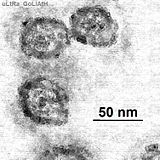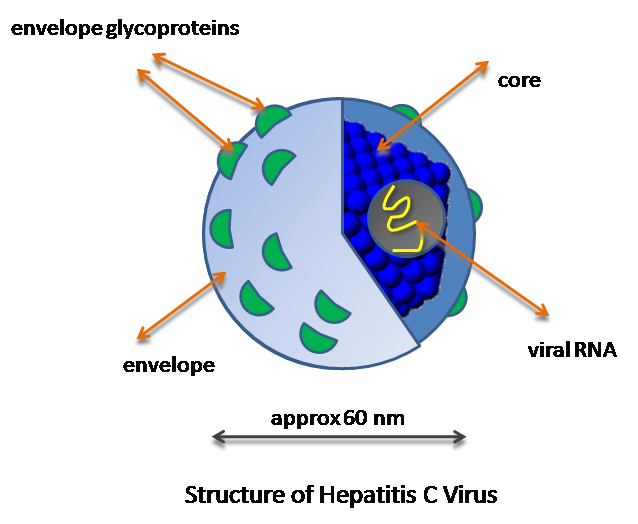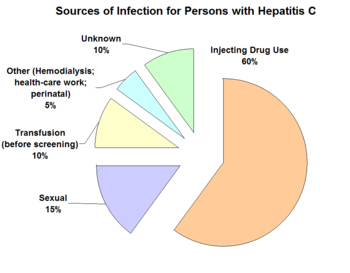Hepatitis C virus: Difference between revisions
imported>Daniel Kupec (New page: {{EZarticle-closed-auto}} ==Classification== Image: Tosco_Refinery.jpg ===Higher order taxa=== Domain; Phylum; Class; Order; family [Others may be used. Use [http://www.tolweb....) |
mNo edit summary |
||
| (69 intermediate revisions by 8 users not shown) | |||
| Line 1: | Line 1: | ||
{{ | {{Subpages}} | ||
{{Taxobox | |||
| color=violet | |||
| name = Hepatitis C virus | |||
| image = [[Image:HCVtaxbox.jpg]] | |||
| virus_group = IV (+ ssRNA) | |||
| familia = Flaviviridae | |||
| genus = Hepacivirus | |||
| sero_complex = x}} | |||
==Classification== | ==Classification== | ||
===Higher order taxa=== | ===Higher order taxa=== | ||
Virus; ssRNA positive strand virus no DNA stage; Flaviviridae; hepacivirus | |||
===Species=== | ===Species=== | ||
Hepatitis C virus | |||
==Description and significance== | |||
The Hepatitis C virus (HCV) was discovered in 1989 at Chiron, Inc. The [[genome]] was located by using [[chimpanzees]] infected with a serum, that was from a patient with non-A, non-B Hepatitis. Through this screening they were able to discover what the virus was that was causing Hepatitis after blood transfusions that were not caused by [[Hepatitis A]] or [[Hepatitis B]]. This virus encodes a single [[polyprotein]] that is about 3,000 [[amino acids]] long.<ref>Worman, Howard J (2002) Hepatitis C: The Hepatitis C virus (HCV). Available: http://www.cumc.columbia.edu/dept/gi/hepC.html</ref> It is processed by host cells and viral proteases. This virus lives and infects the [[liver]] of its host. It reproduces in the [[hepatocytes]] of the liver. It is then spread throughout the body in the bloodstream where it can be transmitted to another host through direct blood to blood contact. It is important for its genome to be sequenced because of the lethal effects of HCV. This virus has been linked to [[cancer]] of the liver, [[cirrhosis]], and has also been linked with many [[HIV]] patients. Also of importance because currently there are 6 different [[genotypes]] of HCV and through testing we have learned that different genotypes react differently to different methods of treatment. | |||
It has been assessed as a world threat in a [[U.S. intelligence and global health|U.S. National Intelligence Estimate]]. | |||
==Genome structure== | ==Genome structure== | ||
The Genome of HCV is approximately 10,000 base pairs long. It contains single [[open reading frame]] (ORF) that encodes for a polyprotein of about 3000 amino acids. At both the 5’ and 3’ ends there are non coding regions. There are about 6 main types of genomic structure for HCV. There are thought to be many frameshift mutations during the replication of HCV, which help lead to its genetic variability. This enables the virus to become harder to track, and also leads to the difficulties in coming up with a cure for it, enhancing its life span as a virus.<ref>http://www.microbiologybytes.com/virology/HCV.html</ref> | |||
==Cell structure and metabolism== | ==Cell structure and metabolism== | ||
HCV is an enveloped icosahedral capsid. It consists of the single strand RNA, and the outside of the envelope is covered with the glycoprotein’s E1 and E2. Part of the problem with HCV is that currently they are unable to culture it in vitro, which makes it difficult for studying its structure and replication processes. With these difficulties some discoveries have been made. The E2 [[glycoprotein]] is very important because it has recently been discovered that it is this that interacts with and binds to the HCV receptor CD81 in liver cells. It is also being suggested that HCV may enter the cell bound to [[LDL]] receptors. Still we are not certain of this, but it is a theory based on the association of HCV particles and beta lipoproteins. Scientists are unsure whether entrance to the cell bound to CD81 or LDL leads to successful infection of the virus (JGV). It is known that once the virus is inside the cytoplasm of the host cell that the RNA genome is directly translated. It is believed that a –RNA strand is synthesized by a replicase composed of NS3-5B and that this will serve as the template for production of +RNA strands. Then through interactions with structural proteins it will become encapsidated, and then they are enveloped by budding in the lumen of the ER. All of this is hypothetical because without the ability to culture it in vitro, and mass produce, it is very difficult to study the virus at all.<ref>Bartenshclager, R and Lohmann,V (2000) Replication of hepatitis C virus. Journal of General Virology. Available: http://vir.sgmjournals.org/cgi/content/full/81/7/1631</ref> | |||
[[Image:HCV_structure.png]] | |||
==Ecology== | ==Ecology== | ||
Hepatitis C virus is only known to infect human hosts. Through implanting into the chimpanzee, it has been determined that they are suitable hosts as well, but it is only known to directly infect humans. This virus is a blood borne virus, and after being replicated in the hepatocytes of the liver it is sent into the blood where it can be transmitted to other hosts. | |||
==Pathology== | ==Pathology== | ||
This virus causes diseases by infecting host cells, called [[hepatocytes]] in the human liver. As of now it is only known to infect humans, and can infect chimpanzees, which is a close relative to the human race. After infecting the hepatocytes the [[RNA]] virus is replicated exponentially and spread through out the body, the blood, and the [[lymphatic system]]. Scientists are still unsure if HCV is caused by a direct cytopahtic effect or host immune-mediated cytolytic response. Most agree that it is probably a combination of the two. For many people infected with HCV the severity of the disease is minimal at most. 80 % of those infected with HCV show no signs or symptoms. If you do show those symptoms would be: | |||
*[[jaundice]] | |||
*fatigue | |||
*dark urine | |||
*abdominal pain | |||
*loss of appetite | |||
*nausea | |||
*vomiting <ref>http://www.chiron.com/public/library/diseases/hcv/hcv_factsheet.jsp</ref> | |||
This virus incurs a very slowly developing disease, as those who have acute Hepatitis C will not develop chronic Hepatitis C for 10 years, cirrhosis for 20 years, and [[hepatocellular carcinoma]] for 30 years. About 15% of people infected clear the body of the virus during the acute phase; the remaining 85% go on to develop chronic hepatitis C. Because of its slow developing nature many chronic sufferers never develop cirrhosis in their lifetime. For others this process does occur and is aided by excessive alcohol consumption and co infection with HIV. There are many factors to the development of HCV, also including the mutations of the virus, and the amount of [[quasispecies]] produced. Besides HIV you may also be co infected with [[HBV]] and [[HAV]] which help speed up the process of liver damage.<ref>http://www.vhpb.org/files/html/Meetings_and_publications/VHPB_Meetings/geneva2002/S2AP1%20Grob.pdf</ref> | |||
== | ==Transmission== | ||
HCV is a blood borne virus and hence is transmitted through the blood. Different ways for transmission are direct blood to blood contact, blood transfusions, organ transplants, sharing needles, sexual intercourse, and sometimes prenatally. Since the development of blood screening for Hepatitis C the rate of acquiring the virus from blood transfusions has dramatically dropped in the developed world. This still poses a threat in underdeveloped societies. <ref>http://www.medicinenet.com/hepatitis_c/article.htm</ref> | |||
[[Image:Infection.png]] | |||
== | ==Treatment== | ||
Telaprevir may help patients who failed other treatments.<ref name="pmid20375406">{{cite journal| author=McHutchison JG, Manns MP, Muir AJ, Terrault NA, Jacobson IM, Afdhal NH et al.| title=Telaprevir for previously treated chronic HCV infection. | journal=N Engl J Med | year= 2010 | volume= 362 | issue= 14 | pages= 1292-303 | pmid=20375406 | doi=10.1056/NEJMoa0908014 | pmc= | url=http://www.ncbi.nlm.nih.gov/entrez/eutils/elink.fcgi?dbfrom=pubmed&tool=sumsearch.org/cite&retmode=ref&cmd=prlinks&id=20375406 }} [http://www.ncbi.nlm.nih.gov/entrez/eutils/elink.fcgi?dbfrom=pubmed&tool=sumsearch.org/cite&retmode=ref&cmd=prlinks&id=20713786 Review in: Ann Intern Med. 2010 Aug 17;153(4):JC2-7] </ref> | |||
==Current research== | |||
February 5, 2008. Researchers at Massachusetts General Hospital Center for Engineering in Medicine have found that [[flavonoid naringenin]], a common compound found in the grapefruit may be helpful in treatment for chronic Hepatitis C patients. The theory behind this is based on the fact that HCV latches on to LDL when it is secreted from liver cells. Flavonoid naringenin has been shown to help lower LDL in other studies. They think that if you combine this antioxidant with antiviral medicines they may be able to limit the development of HCV or even rid the system of it completely. This theory is still awaiting human trial.<ref>http://www.brightsurf.com/news/headlines/35606/Grapefruit_compound_may_help_combat_hepatitis_C_infection.html</ref> | |||
May 9, 2007. New research shows that the risk for getting lymphoma increases when people are infected with HCV. It increases the risk of developing [[non-Hodgkins lymphoma]]. Researchers are thinking that the screening of individuals with HCV can help to determine the factors that lead to cancer. | |||
<ref>http://www.brightsurf.com/news/headlines/30423/Risk_of_lymphoma_increases_with_hepatitis_C_virus_infection.html</ref> | |||
August 13, 2006. At the Monash Institute of Medical Research, they have replicated HCV in a mouse. This was a huge step in solving the mystery of this virus, and it showed that [[protein kinase R]] (PKR) blocked the replication in mice. Not only does it help in figuring out how the immune system tries to stop the virus, but it also may help scientists understand why some people respond better to treatments than others.<ref>http://www.sciencedaily.com/releases/2006/08/060812155645.htm</ref> | |||
==References== | ==References== | ||
[ | {{reflist|2}}[[Category:Suggestion Bot Tag]] | ||
Latest revision as of 11:00, 27 August 2024
| Hepatitis C virus | ||||||||
|---|---|---|---|---|---|---|---|---|
[[image: |200px|]] |200px|]] | ||||||||
| Virus classification | ||||||||
|
Classification
Higher order taxa
Virus; ssRNA positive strand virus no DNA stage; Flaviviridae; hepacivirus
Species
Hepatitis C virus
Description and significance
The Hepatitis C virus (HCV) was discovered in 1989 at Chiron, Inc. The genome was located by using chimpanzees infected with a serum, that was from a patient with non-A, non-B Hepatitis. Through this screening they were able to discover what the virus was that was causing Hepatitis after blood transfusions that were not caused by Hepatitis A or Hepatitis B. This virus encodes a single polyprotein that is about 3,000 amino acids long.[1] It is processed by host cells and viral proteases. This virus lives and infects the liver of its host. It reproduces in the hepatocytes of the liver. It is then spread throughout the body in the bloodstream where it can be transmitted to another host through direct blood to blood contact. It is important for its genome to be sequenced because of the lethal effects of HCV. This virus has been linked to cancer of the liver, cirrhosis, and has also been linked with many HIV patients. Also of importance because currently there are 6 different genotypes of HCV and through testing we have learned that different genotypes react differently to different methods of treatment.
It has been assessed as a world threat in a U.S. National Intelligence Estimate.
Genome structure
The Genome of HCV is approximately 10,000 base pairs long. It contains single open reading frame (ORF) that encodes for a polyprotein of about 3000 amino acids. At both the 5’ and 3’ ends there are non coding regions. There are about 6 main types of genomic structure for HCV. There are thought to be many frameshift mutations during the replication of HCV, which help lead to its genetic variability. This enables the virus to become harder to track, and also leads to the difficulties in coming up with a cure for it, enhancing its life span as a virus.[2]
Cell structure and metabolism
HCV is an enveloped icosahedral capsid. It consists of the single strand RNA, and the outside of the envelope is covered with the glycoprotein’s E1 and E2. Part of the problem with HCV is that currently they are unable to culture it in vitro, which makes it difficult for studying its structure and replication processes. With these difficulties some discoveries have been made. The E2 glycoprotein is very important because it has recently been discovered that it is this that interacts with and binds to the HCV receptor CD81 in liver cells. It is also being suggested that HCV may enter the cell bound to LDL receptors. Still we are not certain of this, but it is a theory based on the association of HCV particles and beta lipoproteins. Scientists are unsure whether entrance to the cell bound to CD81 or LDL leads to successful infection of the virus (JGV). It is known that once the virus is inside the cytoplasm of the host cell that the RNA genome is directly translated. It is believed that a –RNA strand is synthesized by a replicase composed of NS3-5B and that this will serve as the template for production of +RNA strands. Then through interactions with structural proteins it will become encapsidated, and then they are enveloped by budding in the lumen of the ER. All of this is hypothetical because without the ability to culture it in vitro, and mass produce, it is very difficult to study the virus at all.[3]

Ecology
Hepatitis C virus is only known to infect human hosts. Through implanting into the chimpanzee, it has been determined that they are suitable hosts as well, but it is only known to directly infect humans. This virus is a blood borne virus, and after being replicated in the hepatocytes of the liver it is sent into the blood where it can be transmitted to other hosts.
Pathology
This virus causes diseases by infecting host cells, called hepatocytes in the human liver. As of now it is only known to infect humans, and can infect chimpanzees, which is a close relative to the human race. After infecting the hepatocytes the RNA virus is replicated exponentially and spread through out the body, the blood, and the lymphatic system. Scientists are still unsure if HCV is caused by a direct cytopahtic effect or host immune-mediated cytolytic response. Most agree that it is probably a combination of the two. For many people infected with HCV the severity of the disease is minimal at most. 80 % of those infected with HCV show no signs or symptoms. If you do show those symptoms would be:
This virus incurs a very slowly developing disease, as those who have acute Hepatitis C will not develop chronic Hepatitis C for 10 years, cirrhosis for 20 years, and hepatocellular carcinoma for 30 years. About 15% of people infected clear the body of the virus during the acute phase; the remaining 85% go on to develop chronic hepatitis C. Because of its slow developing nature many chronic sufferers never develop cirrhosis in their lifetime. For others this process does occur and is aided by excessive alcohol consumption and co infection with HIV. There are many factors to the development of HCV, also including the mutations of the virus, and the amount of quasispecies produced. Besides HIV you may also be co infected with HBV and HAV which help speed up the process of liver damage.[5]
Transmission
HCV is a blood borne virus and hence is transmitted through the blood. Different ways for transmission are direct blood to blood contact, blood transfusions, organ transplants, sharing needles, sexual intercourse, and sometimes prenatally. Since the development of blood screening for Hepatitis C the rate of acquiring the virus from blood transfusions has dramatically dropped in the developed world. This still poses a threat in underdeveloped societies. [6]

Treatment
Telaprevir may help patients who failed other treatments.[7]
Current research
February 5, 2008. Researchers at Massachusetts General Hospital Center for Engineering in Medicine have found that flavonoid naringenin, a common compound found in the grapefruit may be helpful in treatment for chronic Hepatitis C patients. The theory behind this is based on the fact that HCV latches on to LDL when it is secreted from liver cells. Flavonoid naringenin has been shown to help lower LDL in other studies. They think that if you combine this antioxidant with antiviral medicines they may be able to limit the development of HCV or even rid the system of it completely. This theory is still awaiting human trial.[8]
May 9, 2007. New research shows that the risk for getting lymphoma increases when people are infected with HCV. It increases the risk of developing non-Hodgkins lymphoma. Researchers are thinking that the screening of individuals with HCV can help to determine the factors that lead to cancer. [9]
August 13, 2006. At the Monash Institute of Medical Research, they have replicated HCV in a mouse. This was a huge step in solving the mystery of this virus, and it showed that protein kinase R (PKR) blocked the replication in mice. Not only does it help in figuring out how the immune system tries to stop the virus, but it also may help scientists understand why some people respond better to treatments than others.[10]
References
- ↑ Worman, Howard J (2002) Hepatitis C: The Hepatitis C virus (HCV). Available: http://www.cumc.columbia.edu/dept/gi/hepC.html
- ↑ http://www.microbiologybytes.com/virology/HCV.html
- ↑ Bartenshclager, R and Lohmann,V (2000) Replication of hepatitis C virus. Journal of General Virology. Available: http://vir.sgmjournals.org/cgi/content/full/81/7/1631
- ↑ http://www.chiron.com/public/library/diseases/hcv/hcv_factsheet.jsp
- ↑ http://www.vhpb.org/files/html/Meetings_and_publications/VHPB_Meetings/geneva2002/S2AP1%20Grob.pdf
- ↑ http://www.medicinenet.com/hepatitis_c/article.htm
- ↑ McHutchison JG, Manns MP, Muir AJ, Terrault NA, Jacobson IM, Afdhal NH et al. (2010). "Telaprevir for previously treated chronic HCV infection.". N Engl J Med 362 (14): 1292-303. DOI:10.1056/NEJMoa0908014. PMID 20375406. Research Blogging. Review in: Ann Intern Med. 2010 Aug 17;153(4):JC2-7
- ↑ http://www.brightsurf.com/news/headlines/35606/Grapefruit_compound_may_help_combat_hepatitis_C_infection.html
- ↑ http://www.brightsurf.com/news/headlines/30423/Risk_of_lymphoma_increases_with_hepatitis_C_virus_infection.html
- ↑ http://www.sciencedaily.com/releases/2006/08/060812155645.htm